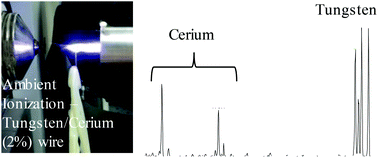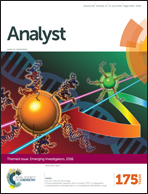Towards universal ambient ionization: direct elemental analysis of solid substrates using microwave plasma ionization†
Abstract
A microwave plasma was used for direct ambient ionization mass spectrometry of solid substrates, rapidly yielding atomic spectra without sample digestion or pre-treatment. Further, molecular spectra for the organic components of the substrate were obtained simultaneously, in an ambient ionization format. Initial characterization of the microwave plasma coupling to an ion trap mass spectrometer was carried out using solution standards and a microwave plasma torch (MPT) configuration. The configuration of the microwave plasma was then optimized for ambient ionization. The atomic and organic composition for samples applicable to nuclear and conventional forensic screening, including explosive/radionuclide mixtures and inorganic/organic gunshot residue component mixtures were successfully determined. The technologies employed are readily fieldable; the feasibility of a multimode ion source that could be coupled with a portable ion trap mass spectrometer for rapid, on-site, elemental, isotopic, and molecular screening of samples is demonstrated.

- This article is part of the themed collection: Emerging Investigators

 Please wait while we load your content...
Please wait while we load your content...